|
Definition of PNe: see wiki
Table of contents:
General properties of PNe (go to to
 | Nine key observational facts that is critical
for morphological classification of PNe were presented by Noam Soker (1997ApJS..112..487S,
page 489) : (click the words to fold/unfold details)
 | Spherical PNe are
PNs without deviation from sphericity. (about
10% of PNe). |
 | Spherical halos
companioned by non-spherical structures inside or outsied, e.g., NGC 6826, NGC 6891, IC 1454. |
 | Jets
along or near their symmetry axes. e.g., NGC
6826, NGC
3242, NGC
7009,
IC 4593. Corradi (1996) estimate that approximately one-fourth of
nonbipolar PNs have FLIERs (ansae). |
 | Central binary stars and
jets. About 15 PNs are known to have a
close binary system at their centers. Of these, only one (K1-2) clearly
shows two jets. |
 | Superwind. In
many cases, the inner elliptical regions of
PNs are formed from a higher mass-loss rate than the more spherical
halos around them (e.g., NGC 6826;
NGC 3242). |
 | Central binary stars and
bipolarity. Only one source, NGC 2346, is
known to have both close binary nuclei and bipolar PN. |
 | Massive progenitors for
bipolar PNe. Bipolar PNs are concentrated
toward the Galactic plane. This and composition differences from
elliptical PNs strongly suggest that progenitors of bipolar PNs are more
massive than those of the rest of PNs. |
 | Expansion velocities of
bipolar PNe. Among different properties,
only expansion velocity is found to be much faster in bipolar PNs than
in elliptical PNs. |
 | Axisymmetrical structure
on the AGB. Many AGB stars and proto-PNs
show axisymmetrical structures, and several Mira variables are observed
to deviate substantially from sphericity. |
|
 | Single star bipolarity:
(click the words to fold/unfold details)(Noam
Soker 1997ApJS..112..487S,
page 492)
- Non-spherical morphology can hardly be produced by single star. The Sun has
rigid body rotation down to r = 0.2 Ro, which indicates little
angular momentum stored inside of the Sun. Rotation speed of a star will
drastically decrease when it swells into RGB or AGB star. Mass loss
fast carries away the angular momentum from a rigid body rotator. Thus, binary
is necessary to produce non-spherical morphologies in the circumstellar
envelopes of AGB stars and PNe.
|
 | Classification of binaries:
(click the words to fold/unfold details)
(Noam Soker 1997ApJS..112..487S,
page 489-492)
 | Extremely wide
binaries: TPNF << Torb,
where TPNF is PN formation time plus PN lifetime (~ 105 yr) and
Torb is the orbital period given by Torb = 2830 * (M1+M2)-1/2
* a3/2 yr (stellar masses M1 and M2
in solar mass unit, star separation a in 200 AU unit). This is usually
corresponding to a >= 5000 AU. The secondary may form a small bubble
inside the nebula. Only when the secondary is a RGB, the bubble can be
easily seen as a bright, low ionization, small area (1015-1017
cm) in the image of PN. |
 | Wide binaries:
TPNF ~ Torb, and usually with 100 AU < a <
1000 AU. Little effect on the circumstellar envelope or at most form an
arc like structure that reminisces the interaction with interstellar
matter (ISM). Jets, if any, may be bended through precession. (Note:
According to newer simulation of Mastrodemos and Morris 1999ApJ...523..357M
and He 2007astro.ph..3639H,
secondary accretion is actually not important in wide binary system and
various quasi-spherical density patterns can form by the orbital motion
of the primary AGB star.) |
 | Close binaries
that avoid common envelopes: They have no
or almost no common envelope phase. Two effects from the secondary: (1)
the tidal force spin up the primary and may cause precession of disk
around the primary. In highly eccentric orbit case, the interaction may
be periodic. (2) accretes mass from the primary. White dwarf (WD)
secondary may cause higher outflow velocity than main sequence (MS)
secondary. The PN might be an elliptical PN. |
 | Common
envelopes: stellar companions. The orbital
motion of secondary stir up surface material of primary into corotation,
and form elliptical PNe, rather than bipolar PNe. (I
don't understand why!! read Bond and Livio, 1990 and Bond 1995) |
 | Common
envelopes: substellar companions. They form
elliptical PNe, as stellar companions do, but (1) The secondary doesn't
cause corotionation of matter and only form common envelope at the tip
of AGB; (2) Less energy and angular momentum released to the common
envelope. |
 | Summary table of the 5 classes of
binaries: (Noam Soker 1997ApJS..112..487S,
page 490)
 |
|
 | PNe morphological classes:
(click the words to fold/unfold details)
 | -----(Noam Soker 1997ApJS..112..487S,
page 493)------ |
 | A spherical structure
-- (without small scale filaments or blobs) caused by single star; |
 | A outer distorted halo +
an inner spherical region -- caused by
interaction with ISM; |
 | Pronounced lobes and a waist in their
equatorial plane -- caused by a close binary
without common envelop phase; |
 |
A ring or a torus -- There is a
strong mass concentration toward the equatorial plane, but there are no
lobes. A common envelope is likely to cause this; |
 |
A mild contrast -- Elliptical PN
with mild contrast between equatorial and polar regions. Caused by
substellar companion or a stellar companion at larger distance in a
close binary system; |
 |
Jets -- binary accretion; |
 |
A displaced and mildly distorted
axisymmetry -- Caused by wide binary, close
binary with large eccentricity, or interaction with ISM; |
 |
Bubbles, blobs and filaments --
In outer parts, by wide binary or passing stars; in inner parts, by wind
interaction; long filaments, by interaction with ISM; |
 |
No axisymmetrical structure
-- Old PNe or PNe moving fast through dense ISM. |
 | -----(Balick 1987AJ.....94..671B,
page 493)------ |
 | They defined common microsopic features of PNe: core, rim, tails, ansae, inner halos, outer halos (round or bipolar). |
 | They defined three morphological classes: round, elliptical and butterfly. |
 | For each class, they defined three types: early, middle and late. |
 | Classes and types belonging to
each class form a 2-D morphologic
classification scheme. Different features
are roughly related to classes and types.
 |
Halos: ubiquitous in round PNe and common in elliptical
PNe, but almost never seen in butterly PNe. |
 |
Ansae and tails: most common among elliptical PNe. Sometimes also
found in butterfly PNe. |
|
 |
Some irregular PN shapes not belonging to any of this scheme may be
caused by extinction effect of foreground objects.
(fig: the 2-D morphology
classification scheme)
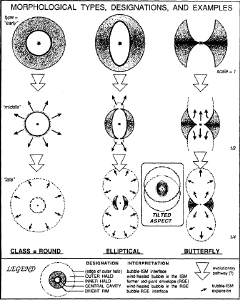 |
 |
Ionization states:
 |
neutral region: show [O I] lines |
 |
ionized region: show Halpha
lines
 |
low ionization level: [N
II] lines are most prominant |
 |
moderate ionization level: [O
III] lines are most prominant |
 |
high ionization level: [He
II] lines are most prominent |
|
|
|
 | Three types of PNe: (click the words to fold/unfold details)
(Zijlstra, A.A., 2007BaltA..16...79Z)
 | Type I PNe: PNe with very close binary in
which the binary companion induces mass loss. |
 | Type II PNe: PNe with intermediate close
binary in which the binary companion only helps shape the mass loss. |
 | Type III PNe: PNe with wide binary in
which the binary companion causes the center of mass to move and so
leads to a spiral embedded in the wind. |
|
 | Statistics of PNe:
(click the words to fold/unfold details)
(Noam Soker 1997ApJS..112..487S,
page 493)
 | Among the 458 PNe, 3-20%
PNe are not affected by companion; 11% (8-13%)
PNe show interaction with stellar companion without common envelope; 23%
(18-34%) PNe show the sign of common envelope
with stellar companion; 56% (48-61%)
PNe show the sign of common envelope phase with substellar companion. (These
conclusions are based upon his supposed connections between PN morphologies
and binary classes.) About 11.6% PNe show signs of interaction with ISM; 5%
PNe show signs of wide binary interaction. Among the 18 single star
(spherical) PNe, 50% show ISM interaction, perhaps because spherical PNe are
usually of large size. |
|
 | Binary birthrate: (click the words to fold/unfold details)
 | It is dependent upon binary
separation A as ~1/A within 10 < A < 106 Ro
(Yungelson et al., 1994ApJ...420..336Y).
But, Soker (2006ApJ...645L..57S)
found that the formation rate of observed PNe is only 1/3 of formation
rate of WD, which indicates that only 1/3 of precursors of WD can form
observable PNe. O. De Marco's conjecture that the majority of observed
planetary nebulae harbor binary systems indicates binary helps form
bright PN. |
|
 | Jet bending: (click the words to fold/unfold details)(Soker
& Bisker, 2006MNRAS.369.1115S)
 | In some PNe, such as eta Carinae and
NGC 6886 (with bending angle of 6°),
the line connecting the center of double bubbles doesn't go through
the center of the nebula, which indicates the double bubbles are bent
towards the same direction. The bubble pairs are usually inflated by
bipolar jets launched from the secondary star. The bending is caused by
the ram pressure from the slow wind from the primary star. The bending
process mainly happens within the distance of the binary separation. See more
examples of bended bubbles/jets in Soker N., Hadar R., 2002MNRAS.331..731S. |
 | Doyle et al., 2000AJ....119.1339D
showed another example: M 2-9 (or PN G010.8+18.0, also called butterfly nebular)
show mirror symmetry of knots and filaments in the bipolar outflow. The
mirror symmetry is believed to be created by bending and precessing
bipolar jets. The bending of the jets could be caused by the ram presure
of the slow AGB wind from the side of the primary AGB star. Zweigle et
al., 1997A&A...324..624Z
mapped CO 1-0 using IRAM single dish, and found CO in an expanding
clumpy torus, with a mean diameter of 6 arcsec. |
|
 | PNe with masers:(click the words to fold/unfold details)
 | H2O masers. IRAS 17443-2949 and IRAS
18061-2505 (Olga et al., 2007, astro-ph/0703502) |
|
 | A review of the shaping of PNe. They
summarized discovered PN morphologies and discussed the potential shaping
agents such as binarity and magnetic fields. (from Balick & Frank, 2002ARA&A..40..439B) |
Observations of PNe
(go to top)
 | Optical/IR
(go to top)
 | The mapped the velocity of Halpha and [N II]
towards a sample of PNe and used a hydrodynamic model of interacting
wind to explain the observed channel maps. (from Balick et al., 1987AJ.....94.1641B) |
 | He systematically summarized the observational
properties of PNe. (from Kwok, 2005JKAS...38..271K) |
 | He summarized the formation of organic compounds
in Planetary Nebulae. PNe and PPNe were
found to possess rich dust and molecular gas through IR and mm
observations. IR emission lines from organic material were found, e.g.,
the AIB (Aromatic Infrared Bands) at 3.3, 6.2, 7.7, 8.6, 11.3 and 12.7 um and some
unidentified IR features around 21um, 30um,
and the extended red emission (ERE) between
650~800nm. Candidates of these features are: PAH
(polycyclic aromatic hydrocarbon), HAC
(hydrogenated amorphous carbon), QCC
(quenched carbonaceous composites) and Kerogen.
The well determined physical condition of the PNe and PPNe is very
helpful to constraining the organic chemistry properties. (from Kwok, 2006AIPC..855..154K) |
 | They find some co-axial rings on the wall
of optical bipolar lobes (HST WFPC2
[N ii] image) of the PN Hb 12. NICOMOS
NIR image showes more structures: bipolar jets
and large arcs. The patterns are projection
of hour-glass structures, similar as in PN Hen 2-104, PN Hen 2-113
and PN MyCn 18, and SN
1987 A. The rings are argued to be created by episodic fast winds. Similar ring structures were
also found in PN M2-9 and related to symbiotic phenomenon. (from Kwok & Hsia, 2007ApJ...660..341K)
(figures: (left to right) 1)
[N II] image of PN Hb 12; 2) NICOMOS image of PN Hb 12; 3)
[N II] image of PN Hen 2-104; 4) [N II] image of PN MyCn 18; 5) [N
II] image of PN M2-9.)

    |
 | They imaged 30 PNe on the Galactic plane in
the Spitzer/GLIMPSE survey. The infrared SED
allows them to differentiate the emission from stellar atmosphere, ionised
nebula and dust grains. 12 PNe were found to show extended dust component
(30~600 arcmin) and strong IR emission: (PNG)18.6-00.0,
295.7-00.2, 298.4+00.6, 301.2+00.4, 309.5-00.7, 321.3-00.3, 329.5-00.5,
329.6-00.4, 332.5-00.1, 333.7+00.3, 333.9+00.6, 340.0+00.9. (from
Kwok et al., 2008ApJS..174..426K). |
 | They found from Spitzer/IRS spectra of a
sample of 40 PNe among which 26 belong to the Galactic
bulge that 21 bulge PNe show dual-dust chemistry (DDC):
PAH feature in 6-14um
and crystalline silicates (CS) beyond 20um.
Surprisingly, DDC is found in all PNe with [WC]-
and wels-type central stars, as well as
some other PNe with central star being neither WC
nor wels. Most observed PNe show crystalline silicates while on a
few exibiting amorphous silicate at the same time. The high detection
rates of CS and PAH in the bulge PNe indicate a recent
chemistry change that could be caused by the last thermal pulse,
because the bulge is known to be deficient of C
stars and low mass O-rich stars do not show
crystalline silicates feature there. (from Perea-Calderon et al.,
2009arXiv0902.1049P) |
|
 | Mm/Radio
(go to top)
- (Hasegawa & Kwok, 2003ApJ...585..475H)
They measured CI (3P1->3P0 at 492 GHz) and CO lines in 3 PNe
(NGC 6302, IRAS
21282+5050, and NGC 7027)and one PPN
(AFGL 2688). Non-detection was reported to another 11 PPNe. They found a trend of increasing CI/CO ratio towards more evolved PPNe.
- (Bachiller et al., 1993A&A...267..177B)
Facts: They mapped CO 2-1 and 1-0 of three evolved PNe using IRAM30m.
Conclusions: An ellipsoidal clumpy ring like CO shell is found in the ring like nebula NGC 6781. The expansion velocity of the CO shell showes an increasing trend with radius, indicating that it was blown up by fast outflow from the central WD. Clumpy relic ring like CO waist are found in the other two bipolar PNe, demonstrate that the blobs in the waist can survive the longest in the nebula.
(figs: Upper row -- NGC 6781, middle row -- NGC 6772, lower row -- VV 47;
left -- Halpha, middle -- CO 2-1 contour map; right -- CO 2-1 grayscale map.)
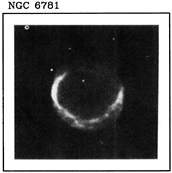 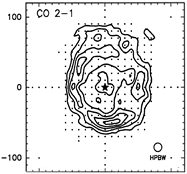 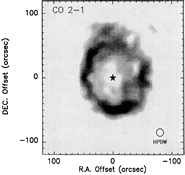
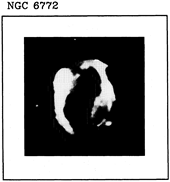 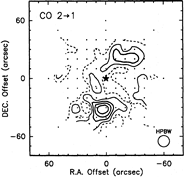
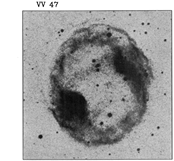 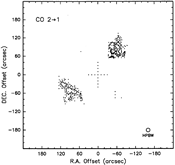
|
|
Hydrodynamics of PNe
(go to top)
 | Lee and Sahai, (2003ApJ...586..319L)
performed hydrodynamic simulation of the propergation of a prescribed
collimated fast wind (CFW) through slow AGB wind, and explored the effects
of different openning angle, velocity and time variation of the CFW. |
Astrochemistry in PNe (go to top)
 | A steady state photodissociation model is presented for the PPN
NGC 7027. The UV field from both the central star and interstellar field triggers the formation
of simple abundance molecules like CH, CH+ and OH, also explain the presence
of HCO+ and CO+ at an assumed temperature of 800K. They argue that molecules are being formed and photodissociated in the such PPN envelope with a timescale
of about 100 yr.(from Hasegawa et al., 2000ApJ...532..994H) |
Examples of PNe
(go to top)
 | NGC 7009 show point symmetry
in its Halpha
image and show bipolar ansae extruding out of the nebula. (from Yolanda's
show in the LSG group meeting on 2007, July 24 at ASIAA) |
 | NGC 6302 (IRAS 17103-3702)
- the bug nebula, a very young PN. Very complex CO
emission morphologies were found in this bipolar nebula by Dinh-V-Trung et
al., 2008ApJ...673..934D,
using the SMA. |
 | Me 1-1 is peculiar ring PN. Optical
spectroscopy shows that the central star is a 3.5 Msun stars with Teff =
4500 K, log g = 2.0, L* = 370 Lsun, and spectral type of K(1-2)II at a
distance of 6 kpc. It may be on the tip of RGB. The central star is shifted
by 400 AU w.r.t. the PN and so may reside in a binary
system. It may has a
edge-on disk with expansion velocity of 10-13 km/s. Broad wing (~600 km/s)
is seen in Halpha emission.(from Pereira et al., 2008, A&A, accepted) |
 | PN M 2-19 -- a PN with known eclipsing binary
(from Miszalski et al., 2008A&A...488L..79M) |
 | PN H 2-29 -- a PN with known eclipsing binary
(from Miszalski et al., 2008A&A...488L..79M) |
 | PN M 3-16 -- a PN with known eclipsing binary
(from Miszalski et al., 2008A&A...488L..79M) |
 | K3-35 (IRAS 19255+2123)
-- one of the two PNe known to have H2O maser
emission up to 2007. The maser arises from a rotating
and expanding torus and far tips of the ~800 year old jets. (Miranda et al., 2001). It's also the only PN
that shows OH 1720 MHz masers. (Gomez et al., 2005) |
 | IRAS 17347-3139 -- one of the two PNe known
to have H2O maser emission up to 2007. The
maser also comes from a torus.
(Gregorio-Monsalvo et al., 2004) |
 | V1018 Sco -- an optical PN around a pulsating AGB star. (Cohen et al., 2006) |
|
![]()